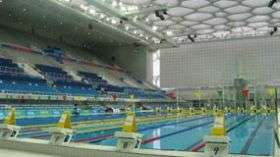August 12, 2008 weblog
It's The Water: Beijing Olympic Swimmer Provided State-of-Art ProMinent Ozone Technology

(PhysOrg.com) -- As Olympic records are being broken left and right by Michael Phelps, questions have been raised do we have a performance enhancing water issue. Some attribute the gold hanging around Olympiad Phelps is the result of a Superman fabric developed by Speedo. In fact, aside from a truly phenomenal performances by the swimmers, it could be the water. ProMinent, the brainchild of Professor h.c. Viktor Dulger in Heidelberg developed the first electronic solenoid driven dosing pump known as the Ozone Technology system for sanitizing pools in 1971. The system does not rely on chlorine which is viewed as harmful to swimmer's lungs, eyes and may cause skin rashes. ProMinent is a leader world-wide with operations in China, Germany, Hungary and South America.
According to ProMinent, the Ozone technology built and utilized by the Water Cube is the most powerful oxidation agent and disinfectant that exhibits an extremely broad and effective biocide spectrum. It is an environmentally and human-friendly technology that generates ozone from pure oxygen or from oxygen in the ambient air and meter it into the water. Even in atmospheres with high humidity the facility will work effectively. ProMaqua products will be used for water treatment along with seven Bono Zon series Ozone generating systems.
The challenge met by ProMinent was to ensure pure water quality as required by standards set by the Olympic Committee for the six training, diving, and competition pools. The mission was accomplished with a programmable logic controller, display panel for monitoring with an operator control panel. A total of 18 Sigma and Vario diaphragm metering pumps in combination with four Dulcomarin controllers and nine D1c controllers ensure exact measurement of disinfectants, maintain pH-balance and flocculates. All water measurements are monitored by 37 sensors.
According to a study conducted by Dr. Jose Jacobs of the University of Utrecht in the Netherlands chlorine interacts with other substances such as urine and sweat to produce an irritation in the respiratory tract. The chloromines comes in various types all with some to marked impact on the swimmer. A study of nearly 624 swimming teachers and employees connected to swimming pools suffered increases in sinusitis, throat, respiratory illnesses. The research report confirms findings by physicians in the USA and elsewhere of increased vulnerability to asthma, allergies and other respiratory illnesses.
In addition, the Water Cube has an advanced water filtration system which takes into account Beijing's need to conserve limited water resources. The water filtration system will run the backwash water through a two-stage filtration system before returning it back to the pool. Engineers installed a unique breeze system that runs gently across the water to remove any trace of disinfectant aromas.
The Ozone technology is prevalent in numerous European countries and now in Beijing China. There are alternatives to chlorine systems, but none that are uniformly agreed by scientists, medical specialists as gentle on humans and the environment. The United States appears to show interest in this technology and some Ozone technology sites are currently in use.
Taking nothing away from the exceptional skill, years of training and abilities of Michael Phelps et.al. It doesn't hurt to have some healthy clean water surrounded by an astounding Water Cube of LED lit bubbles.





















